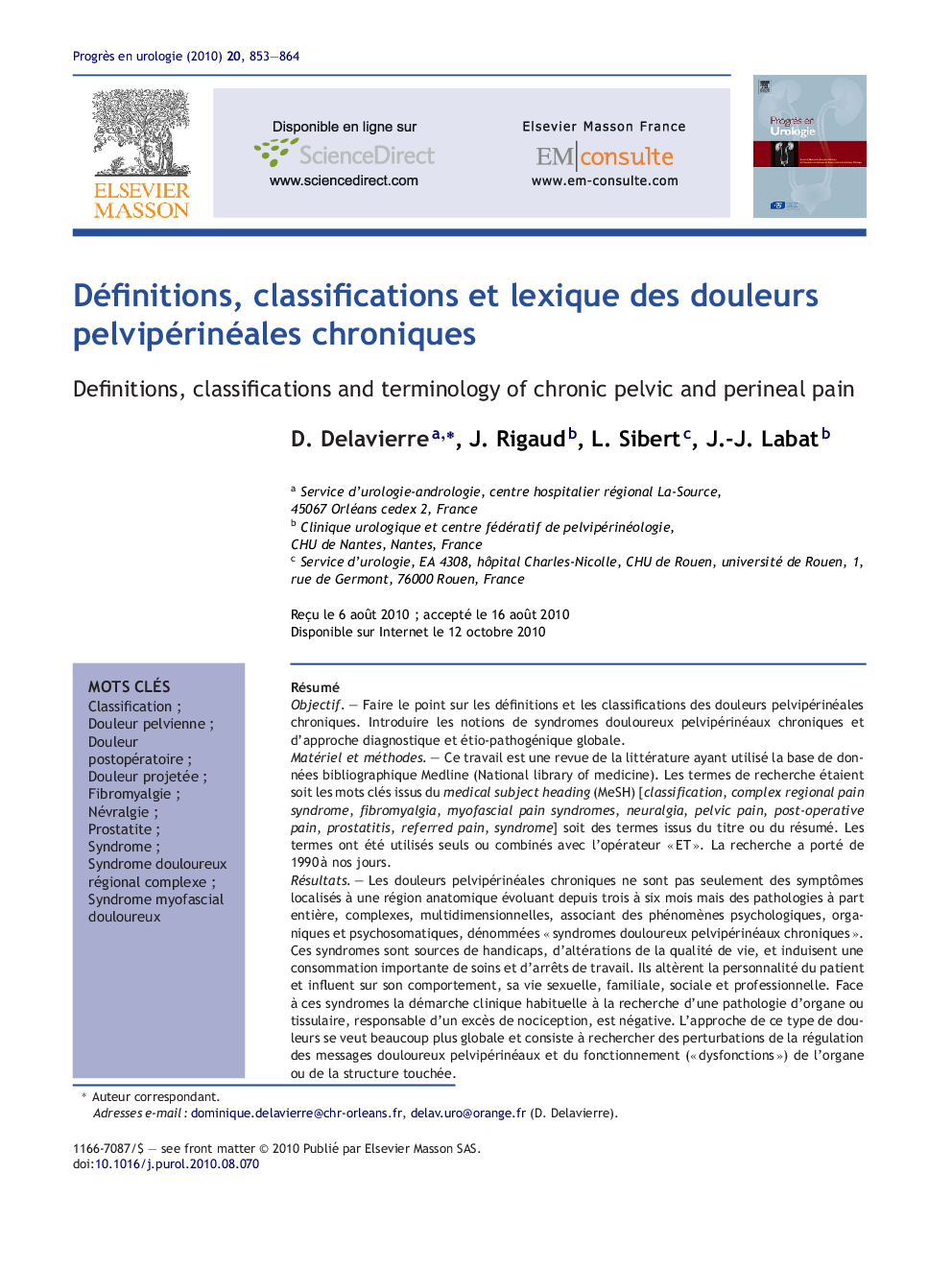| کد مقاله | کد نشریه | سال انتشار | مقاله انگلیسی | نسخه تمام متن |
|---|---|---|---|---|
| 3823744 | 1246724 | 2010 | 12 صفحه PDF | دانلود رایگان |

RésuméObjectifFaire le point sur les définitions et les classifications des douleurs pelvipérinéales chroniques. Introduire les notions de syndromes douloureux pelvipérinéaux chroniques et d’approche diagnostique et étio-pathogénique globale.Matériel et méthodesCe travail est une revue de la littérature ayant utilisé la base de données bibliographique Medline (National library of medicine). Les termes de recherche étaient soit les mots clés issus du medical subject heading (MeSH) [classification, complex regional pain syndrome, fibromyalgia, myofascial pain syndromes, neuralgia, pelvic pain, post-operative pain, prostatitis, referred pain, syndrome] soit des termes issus du titre ou du résumé. Les termes ont été utilisés seuls ou combinés avec l’opérateur « ET ». La recherche a porté de 1990 à nos jours.RésultatsLes douleurs pelvipérinéales chroniques ne sont pas seulement des symptômes localisés à une région anatomique évoluant depuis trois à six mois mais des pathologies à part entière, complexes, multidimensionnelles, associant des phénomènes psychologiques, organiques et psychosomatiques, dénommées « syndromes douloureux pelvipérinéaux chroniques ». Ces syndromes sont sources de handicaps, d’altérations de la qualité de vie, et induisent une consommation importante de soins et d’arrêts de travail. Ils altèrent la personnalité du patient et influent sur son comportement, sa vie sexuelle, familiale, sociale et professionnelle. Face à ces syndromes la démarche clinique habituelle à la recherche d’une pathologie d’organe ou tissulaire, responsable d’un excès de nociception, est négative. L’approche de ce type de douleurs se veut beaucoup plus globale et consiste à rechercher des perturbations de la régulation des messages douloureux pelvipérinéaux et du fonctionnement (« dysfonctions ») de l’organe ou de la structure touchée.ConclusionLes définitions et classifications actuelles des douleurs pelvipérinéales chroniques intègrent les concepts de syndromes, de pathologies fonctionnelles et d’approche globale. Elles s’éloignent du cadre strict des organes et des processus médicaux habituels (infectieux, inflammatoires, métaboliques, endocriniens) et recentrent les pathologies douloureuses sur la douleur elle-même et les symptômes associés.
SummaryObjectiveTo review the definitions and classifications of chronic pelvic and perineal pain and to describe the concepts of chronic pelvic and perineal pain syndrome and the global diagnostic and aetiopathogenic approach.Material and methodsA review of the literature was performed by searching the Medline database (National Library of Medicine). Search terms were either medical subject heading (MeSH) keywords (classification, complex regional pain syndrome, fibromyalgia, myofascial pain syndrome, neuralgia, pelvic pain, postoperative pain, prostatitis, referred pain, syndrome) or terms derived from the title or abstract. Search terms were used alone or in combinations by using the “AND” operator. The literature search was conducted from 1990 to the present time.ResultsChronic pelvic and perineal pain does not only consist of symptoms localized to an anatomical region present for 3 to 6 months, but also constitutes a distinct, complex, multidimensional disease entity, comprising psychological, organic and psychosomatic phenomena, called chronic pelvic and perineal pain syndromes. These syndromes are responsible for disability, impaired quality of life, and induce considerable health care consumption and sick leave. They alter the patient's personality and affect his or her behaviour, sex life, family life, social life and work life. The usual clinical approach to these syndromes, looking for an organ or tissue disease responsible for pain, is negative. The approach to this type of pain must be much more global and consists of looking for disturbances of the regulation of pelvic and perineal nociceptive messages and dysfunction of the organ or structure concerned.ConclusionThe current definitions and classifications of chronic pelvic and perineal pain comprise the concepts of syndrome, functional disease and global approach and differ from the strict organ-based context and the classical medical approach (infectious, inflammatory, metabolic, endocrine) in order to focus pain syndromes on the pain itself and the associated symptoms.
Journal: Progrès en Urologie - Volume 20, Issue 12, November 2010, Pages 853–864